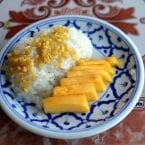Ingredients
Scale
- 100 gr 3.5 ounces Thai Sticky Rice or Thai Glutinous Rice (available in Asian grocery stores)
- 300 ml 10 fluid ounces 100% Coconut Milk
- 60 gr 2.1 ounces Medjool Dates
- ¼ tsp Himalayan Salt
- 1 tsp Organic Corn Starch
- 2 ripe Mangoes
- 1 tsp toasted Sesame Seeds
Instructions
- Before you start, make sure you have the right rice. Using regular rice would completely change the texture of this recipe. The only acceptable alternative is to use black sticky rice, which is also commonly used in various desserts typical of South East Asia.
- Soak the dry sticky rice in water for about 1 hour to get rid of the excessive starch. Drain the rice and rinse it thoroughly.
- Using a steamer, cook the rice over low to medium heat for about 20 minutes.
- While the rice is cooking, start preparing the coconut sauce by blending coconut milk, salt and dates in a high speed blender (I used a Vitamix) until completely smooth. Replacing white sugar with dates is the key to turn this dish into a refined sugar free dessert.
- Set aside 2/3 of the coconut milk & date blend (you’ll mix this to the rice itself) and use the rest to prepare the thicker coconut sauce that you’ll top your dessert with.
- Place the liquid mixture for the thicker sauce in a pan over low heat and sift in the corn starch, mixing constantly to prevent lumps until the cream is thick and velvety.
- When the rice is ready, transfer it into a large pan over low heat and pour the remaining 2/3 of coconut blend over it, stirring gently until the liquid is completely absorbed.
- Place the sticky rice on a serving dish. Peel and slice the mangos and arrange them next to the rice. Pour the thicker sauce over the rice and sprinkle some toasted sesame seeds on top.
- Enjoy!!
TIPS:
- In order to create a nice contrast of flavors and temperatures, pair cool slices of mango with warm sticky rice soaked in a bath of lukewarm coconut cream.
- To know when the glutinous rice is steamed to perfection, look at it and make sure all the grains became entirely translucent.
- Adding a tiny bit of salt guarantees an extraordinary outcome and creates even more contrast among the many, delicious flavors of this dessert! Sweet, tangy and salty at the same time.
- The traditional Mango Sticky Rice calls for a smattering of fried yellow mung beans on top of the rice (as you can see in the photo), adding a crunchy taste to the chewy perfection of the rice. To keep this recipe lighter, replace the fried mung beans with toasted sesame seeds.
- If you want to opt for a colorful take on the tradition but still keep this dish very Thai, you can give your rice a bright shade of purple and green (see photo) using natural Asian colorings. Thai people in fact use to serve their Mango Sticky Rice infused with Butterfly Pea flowers (a climbing vine whose plants produce a lilac, shell-shaped efflorescence) or with Pandanus leaves (a tropical plant widely used in Southeast Asian cuisine as a flavoring). If you can manage to find these plants, you can simply add their blossoms or leaves into the rice’s steaming water, and the trick is done.
- If you order Mango Sticky Rice in restaurants stay alert! Some times they replace corn starch with wheat flour (aka pure gluten!!) to thicken the coconut sauce, so definitely double check with your waiter before you order!
